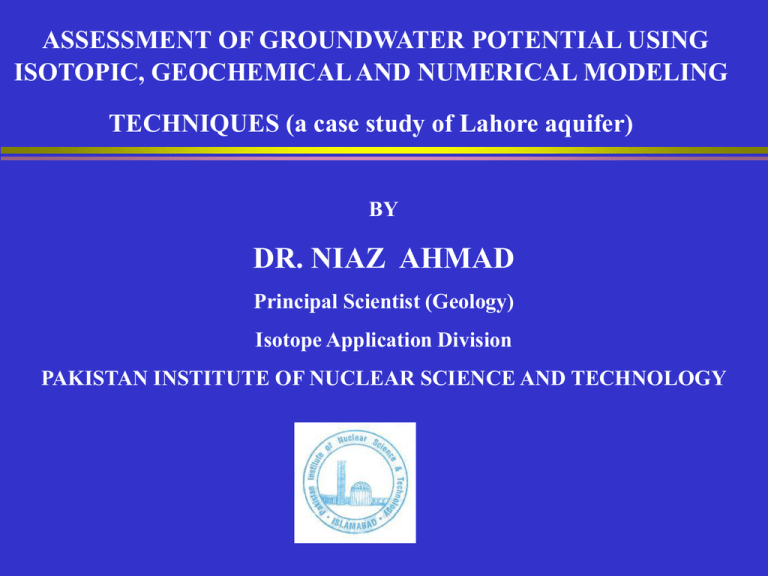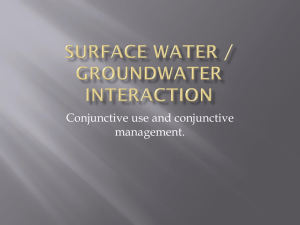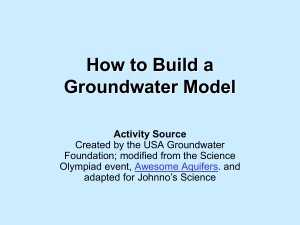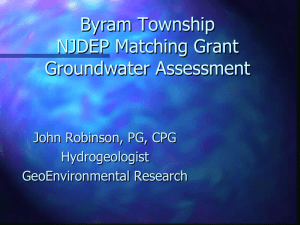introduction to groundwater modeling, a case study of
advertisement

ASSESSMENT OF GROUNDWATER POTENTIAL USING ISOTOPIC, GEOCHEMICAL AND NUMERICAL MODELING TECHNIQUES (a case study of Lahore aquifer) BY DR. NIAZ AHMAD Principal Scientist (Geology) Isotope Application Division PAKISTAN INSTITUTE OF NUCLEAR SCIENCE AND TECHNOLOGY OVERVIEW OF THE TALK • • • • • Evolution of Indus River System Aquifers and Groundwater Recharge and Discharge Groundwater Quantity and Quality Case Studies: Lahore Aquifer EVOLUTION OF INDUS RIVER SYSTEM • As the Himalayas gained their maximum height, the present watershed system of Indus, Brahma-Putra and Ganges emerged and attained the present geographical position • The course of the rivers Indus, Brahma-Putra, Ganges and their tributaries is constantly changing, as the slope of the land is changing due to tectonic stresses • The Himalayas are still rising but due to erosion, they have attained a steady height • The river systems are responsible for the development of thick pile of sediments (~2 KM thick) to the south from Himalayan foothills to the Arabian Sea Delta • The alluvial sediments constitute aquifers which store huge amount of fresh water which is termed as groundwater IMPORTANT FEATURES OF GROUNDWATER • Upper part of Lithosphere (approximately 1 KM) supports fresh groundwater aquifers • To the depth of approximately 800 meters below the water table, about 4 million cubic kilometers of water is present (Singh, 1992) • In the upper 800 meters of the continental crust, the groundwater volume is 3000 times greater than that of all the rivers at any one time and about 20 times greater than the combined volume of water in all the rivers and lakes together. • Surface water bodies (Rivers & Lakes) respond rapidly to rain events but; • Groundwater has a much longer natural accumulation and discharge time Total Amount of Groundwater Available in Pakistan • Fresh groundwater is present along the rivers about 10 km to each side to the depth of 1 km • Total amount of fresh groundwater is about 25000 km3 • IMPORTANT FEATURES OF GROUNDWATER • Groundwater is buffered against short-term weather and climate processes • The huge reserves of fresh groundwater are not being renewed wholly every year when compared to exploitation rate by pumping • Large scale tapping of aquifers is virtually equivalent to a process of nonrenewable mining for water • It moves through the geological materials at a slower rate and residence times in the 10’s, 100’s and even 1000’s of years are not uncommon (Freeze and Cherry, 1979) • Because of its long residence time in aquifers, groundwater is highly vulnerable for pollution and overexploitation by pumping • overexploitation leads to salinization • Knowledge of the recharge rate is essential for managing the sustainable extraction of potable water Composition of Aquifers • The Indus Basin alluvium consists of alternating layers of clay, silt, sand and gravels deposited by meandering rivers in different proportions • The source materials originate from the erosion of rising Himalayan rocks • Groundwater quantity in an aquifer depends on the transmission and storage properties of that aquifer • Chemistry of the rocks plays vital role in the evolution of groundwater quality Composition of Aquifers ---------cont • The aquifers are constantly recharging from the watershed areas and the resulting groundwater is flowing towards the sea • In the way groundwater is interacting with the surrounding rocks and dissolving the chemical content • Due to its high dielectric constant, water is the excellent solvent • With dissolving salts its hunger for dissolving more salts increases, its salinity increases with time • Due to mixing of fresh water in the way, groundwater maintains its quality • Due to global warming if the precipitation patterns change and the drought periods extend, the groundwater quality will also be affected as a result of less fresh water recharge EXPLOITATION OF GROUNDWATER • With the dawn of scientific era and development in petroleum industry, it is now possible to drill a well even more than 1 kilometer depth • Since 1960, a large number of tube wells were installed to extract groundwater for agriculture and drinking purposes • Recharge is an important component of groundwater, if recharge and discharge do not match overexploitation starts • Over-exploitation gives way to problems of pollution, salinization, increased cost of water extraction and resource depletion Important Diagnostics of Groundwater Before Exploitation • • • • • Identification of recharge mechanism Surface water/ Groundwater interaction Transmission/storage properties of aquifers Residence time of water within the aquifer Water quality (physical, chemical & biological) Tools for Investigation • • • • Isotopes Chemical analyses Mathematical Geophysical (resistivity, seismic etc) Case Studies: Lahore Aquifer • IDENTIFICATION OF RECHARGE MECHANISM Identification of Recharge Mechanism of Lahore Aquifer using 18O Isotope Information GMWL -20 -30 60 Rain 50 -40 D (‰) 40 DR 30 -50 20 Ravi -60 10 GMWL LCW -70 0 BRBDC -9 -80 -12 -11 -10 -9 -8 18O (‰) -7 -6 -5 -4 -8 -7 -6 -5 Frequency histogram of 18O (‰) -4 Identification of recharge mechanism in deep groundwater of Lahore aquifer by 18O concentrations in 2006 Bund Road -6.5 g zan o M -7.5 0 ad pur Ro Feroze Rai lwa y Li ne Model Town 5 km Scale -8.5 3D view of 18O concentration of deep groundwater of Lahore in 2006 AN INNOVATIVE FINDING OF A GEOLOGIC FAULT An innovative finding is reached based on the temperatures in the wells Temperatures above normal are found in a linear belt in NE-SW direction The anomalous increase in temperatures is interpreted as the presence of active geologic fault in the Lahore area Due to sliding of the fault, frictional heat is generated, which is increasing the temperatures of the groundwater in contact with the fault area 3500000 SH-3 SH-4 SH-1 192 Temperature Variation 0C 3495000 123 24 - 27.9 28 - 31.9 32 - 33.9 34 - 35 149 191 55 148 57 194 180 38 77 74 68 152 75 168 167 Geo logi cF ault Line 206 3470000 425000 195 196 200 202 162 117 110 163 3475000 217 161 106 205 112 N 160 201 157 3480000 214 212 159 104 187 213 158 169 80 156 70 3485000 186 184 210 208209 188 182 189 207 211 151 66 174 137 185 76 63 173 172 175 128 153 60 61 147 150 14 176 154 62 155 190 178 179 40 59 16 170 7 146 53 3490000 169-A 147 54 181 44 171 198 197 216 215 199 183 165 204 118 203 27 164 430000 435000 166 440000 445000 Water Supply from Lahore Aquifer •Whole supply to the public and industry is from groundwater reservoir •About 400 tube wells (each ~2.5cusecs) are in operation under the jurisdiction of WASA, LDA -About three fourth of WASA is extracted by private stakeholders •Total abstraction is about 800 million gallons per day •We can say a canal of the size of Lahore Canal is operating from the aquifer to the surface •Water table is lowering at the rate of 2.5 feet per year •Aquifer capacity is depleting every year •A large depression cone is producing surrounding the Mozang area •As a result more saline water is intruding the aquifer from the south Water Table Conditions of Lahore Aquifer In 1960 before pumping, water table was at 210 m above mean sea level, about 5 to 6 meter below surface In 1989, a depression cone is visible at Mozang area as a result of pumping, Water table lowered to 191 m from 210 m amsl, i.e. Water table lowered 19 m from 1960 @ 1m / year N Mozang 0 2 km Scale In 1998, Water table further lowered to 185 m from 191m in 1989 R av i Ri v er i.e. lowered 6 m further in 9 years Mozang N 0 2 km Scale Industrial Area Military Engineering Services Green Town Township Shahdara Mozang Data Nagar Garden Town Allama Iqbal Town Mustafabad Mughal Pura Shimla Hill Ravi Road City Baghbaan Pura Misri Shah Gulberg Sub Div Ichhra Sub Div 36 34 32 30 28 26 24 22 20 18 16 14 12 10 8 Samanabad Sub Div Islam Pura Sub Div Depth to Water Table (m) In 2003, maximum water table depths are at Mozang and Ichhra i.e, 36 m below surface which was 5 m in 1960 Maximum Water T able Depth Average Water T able Depth Minimum Water T able Depth Salinization Problem of Lahore Aquifer • EC and Cl can be used to determine the salinity condition of Lahore aquifer • Chloride is more reliable as it is considered a conservative anion due to its less participation in chemical reactions • Spatio-temporal measurements of chloride could be reasonably used to determine the increase of salinity in an area • Once the water enters the geologic formations, its salinity goes on increasing with the passage of time. It changes from fresh water to brackish water and then to brine. Salinity of water could only be decreased by mixing of fresh water in the way. EC (S/cm at 25 0C) av R r ve i R i Bund Road 840 790 M oz an g nal re Ca o h a L 740 690 640 590 540 To del Mo wn 490 u ze P Fero 5 km 440 Scale ad r Ro Ra ilwa yL ine 0 EC contours of deep groundwater in 2006, Lahore area 390 340 EC (S/cm at 25 0C) 3D view of EC parameter Cl (ppm) 47 45 43 41 Mozang 39 37 o ze Fer Pur 35 d Roa Mod el To wn 33 31 5 km Ra ilw ay Lin e 0 29 Scale 27 Contours of chloride measured in deep groundwater of Lahore aquifer in 2006 3D view of chloride concentration water table contours Chloride contours 43 41 Mozang R av i Ri 45 v er 47 Mozang N 39 37 o ze Fer Pur 35 d Roa Mod el To wn 33 31 0 5 km Ra ilw ay Lin e 0 29 Scale 27 2 km Scale Reasons of Salinization • • • • • Lahore has a large network of unlined sewerage drains Water is leaking from these drains to shallow aquifer Salinity of shallow aquifer is increasing A large depression cone has developed in the Mozang area As the aquifer is unconfined, Shallow saline groundwater is making its way to the deep aquifer , where it is mixing with the deep relatively fresh groundwater • As a result, the salinity of deep aquifer is increasing in the central city area (Mozang, Ichhra, Gawal Mandi, Assembly Hall) Water Types of Lahore Aquifer • Major chemical ions dissolved in groundwater are Ca, Mg, Na, K, CO3, HCO3, SO4 and Cl • Concentrations of these ions should be determined before use at homes, industry and agriculture • There are different graphical methods for classification of groundwater types in an area HYDROCHEMICAL EVIDENCE OF LAHORE AQUIFER About 175 samples were collected from Shallow and Deep aquifer, Canals, Drains and River Ravi EC, pH and Temperature were measured in the field Major Cations (Na, K, Ca, Mg) and Anions (carbonates, bicarbonates, sulfate, chloride) were analyzed in the laboratory For interpretation cations and anions were lumped into three variables respectively Their milli-equivalent/L percentages were calculated 80 Water Types Shallow Deep Sewerage Canal River 60 A TRILINEAR GEOCHEMICAL MODEL REPRESENTING DIFFERENT GROUNDWATER TYPES IN THE LAHORE AREA. THE METHODOLOGY OF THE TRILINEAR MODEL WAS DEVELOPED BY PIPER (1944) 80 60 40 40 20 20 Mg SO4 80 80 60 60 40 40 20 20 80 Ca 60 40 20 20 Na+K HCO3+CO3 40 60 80 Cl SO4 Water Types 80 Shallow Deep Sewerage Canal River 60 40 20 HCO3 Na+K 80 60 40 20 Mg 80 60 40 20 Ca 20 40 60 80 Cl A DUROV GEOCHEMICAL MODEL REPRESENTING DIFFERENT GROUNDWATER TYPES IN THE LAHORE AREA. THE METHODOLOGY OF THE MODEL WAS DEVELOPED BY A RUSSIAN SCIENTIST DUROV (1948) INNOVATIVE MULTI-RECTANGULAR DIAGRAMS (MRDs) DEVELOPED AT PINSTECH Classification of water types using innovative MultiRectangular Diagram Model HCO3 ( meq / l % ) SO4 ( meq / l % ) Cl ( meq / L % ) 100 50 7 calcium bicarbonate 100 0 magnesium bicarbonate 50 sodium bicarbonate 0100 sodium chloride 49 69 50 0 0 18 0 100 100 50 0 Ca ( meq / L % ) Mg ( meq / L % ) 50 50 100 Na ( meq / L % ) Important benefit of MRDs classification of groundwater are; •Groundwater types are clearly singled out, which is not possible by previous diagrams •It also helps to mark the zones with different groundwater quality by plotting a representative symbol on the location from where the sample is collected. •i.e, Hydro-chemical facies maps can be prepared Water types differentiated with MRDs and plotted on the sample collection locations in the area Calcium Bicarbonate Magnesium Bicarbonate Sodium Bicarbonate Sodium Sulfate Sodium Chloride SH-2 SH-5 SH-3 SH-4 SH-1 192 123 149 191 55 148 57 194 146 180 54 38 178 181 61 150 190 77 152 75 213 158 151 217 159 104 160 168 167 106 196 195 201 157 calcium bicarbonate type 214 80 70 sodium bicarbonate type 212 169 156 177 137 186 187 208 184 210 209 188 182 189 207 211 76 74 66 68 174 176 185 153 147 173 172 128 154 60 155 14 7 179 40 59 63 16 170 175 53 62 44 171 169-A 126 161 200 198 197 216 215 199 202 183 205 206 163 112 162 117 110 165 204 118 0 10 km 203 27 Scale 164 166 History of movement of groundwater interpreted with chemical ions I.e. Sodiumcalcium relationship in Lahore 90 80 350 70 300 60 250 50 200 R-Ravi-1 40 150 30 100 20 R-Ravi-2 BRBD LH-Canal 50 10 0 0 0 20 40 60 80 100 0 10 20 30 40 50 60 70 80 Sewerage Contamination of Lahore Aquifer • Groundwater from all the sampled wells (111) was tested for Coliform bacteria to observe the sewerage contamination • It appears in 15 wells • Five wells were tested in Shahdara Area, coliform appeared in all these wells • Water seepage from sewerage drains is polluting the deep good quality groundwater • On the other hand, Sewerage water from all the city is disposed of to the river Ravi without any treatment. As the river Ravi is recharging the underground aquifer, sewerage water is also seeping to the deep aquifer thereby polluting it Legend coliform count well No. 11 3 SH-5 38 SH-4 High SH-2 High SH-3 SH-1 2 154 5 3 150 2 74 151 1 1 2 169 156 70 9 0 10 km 165 2 3 Scale 27 164 Location of pumping wells infected by fecal coliform GROUNDWATER FLOW AND CONTAMINANT TRANSPORT MODELING • CASE STUDIES of LAHORE USE OF MODELING TOOLS IN GROUNDWATER AQUIFERS • Modeling tools helps for ASSESSMENT & MANAGEMENT OF AQUIFERS WHAT IS A MODEL • A model is any device that represents an approximation of a field situation • Physical models (sand tanks; simulate groundwater flow directly) • Mathematical models simulate groundwater flow indirectly by means of a governing equation thought to represent the physical processes that occur in the system • A model is not a replica of reality • Rather, a structured environment for thinking through a problem WHY MODELS ? Groundwater Hydrologists are often called upon to predict the behavior of groundwater systems by answering questions like: WHY MODELS ? • What changes can be expected in groundwater levels in the aquifer beneath Lahore in the year 2020 • How will a change in stream stage (River Ravi) affect the water table in an adjacent alluvial aquifer WHY MODELS ? • What is the capture area for a well field that furnishes municipal water supplies to the city • What is the most likely pathway of contaminants if the toxic materials enter the groundwater environment FLOW MODELS Are used to estimate the spatial and temporal variation of quantity of water in the aquifers TRANSPORT MODELS • Are used to assess the contaminant transport behavior in groundwater regime leaked from • Landfill sites • radioactive repositories • other sources AdvectionDispersion Equation solved by MT3D D C ij x x i j Dispersion - x (vi C ) + i Advection q s Cs - [C + b S] = R C Sink/Source Reactions t Retardation Aquifer Main Features • 400+ m thick Quaternary Alluvial Deposits (Sands with clay lenses) • High K = 26 to 158 m/d • Sy = 0.07 - 0.25 • Recharge Rates = 40 - 100 mm/yr • Irrigation canals and influent river Ravi • Over-pumping in Lahore Countours of water level observations in Nov. 1989 N 0 2 km Scale FLOW MODEL OF LAHORE AQUIFER A Model was developed, which is digital equivalent to actual Lahore aquifer DATA NAGAR ASSEM BL Y HAL L M UGHAL PURA SADAR BAZAR LAHORE CITY CITY CANTONM ENT GUL SHAN_ E_ IQBAL PARK M ODEL TO WN BR BD CANAL RA VI RI VE R N UPPER C HE NAB C AN AL Ymax= 3531000 m 74 E Ymin = 3439000 m 31 15 N Xmin = 391000 m Distance= 79 Km Xmax = 470000 m Map of Lahore on UTM Coordinates Aquifer layers constructed from bore hole lithologic logs Cross-sectional view of model layers in Visual Modflow Plan view of the model area showing: River boundaries Constant Head Boundary(NE) General Head Boundary(NW) Inactive Cells Grid Mesh Pumping Wells in the Visual Modflow Ravi River Lahore Canal Steady State calculation before pumping Groundwater Flow Conditions 1910 - Pre-pumping 1960 - beginning of pumping Contours of calculated heads with steady state model in 1989. Model also shows two depression cones as shown in observed head contours. These heads were used as initial heads in transient simulations Countours of water level observations in Nov. 1989 N 0 2 km Scale Calculated Water Table Contours in 1998 Mozang N 0 2 km Scale Water table contours above mean sea level (meters) in Nov. 1998 3D view of transient flow model Depression cone is visible Water is crossing underneath the River Ravi and Lahore Canal Predicted water table contours in 2018 by Visual Modflow DELINEATION OF WELL HEAD PROTECTION ZONE Transient transport simulation: Particles introduced at one of the waste disposal site are captured by the screens of pumping wells CONCLUSIONS • Water table of Lahore aquifer is lowering down at a rate of about 3 feet per year • A depression in the water table has produced • Generally, deep aquifer (≥ 200 m) has less salinity as compared to shallow aquifer (≤ 50 m). Sewerage drains are adding salinity to shallow aquifer. Deep aquifer is getting saline in the areas where water table has maximum depth. This salinity increase is due to mixing of more saline shallow water with deeper fresh water under the action of high hydraulic gradient. • Groundwater of Lahore Aquifer consists of calcium bicarbonate, magnesium bicarbonate and sodium bicarbonate types CONCLUSIONS ------continued • chloride is found Dominant underneath the central city area (Assembly Hall, Mozang, Nisbat Road etc.) in both shallow (motor pumps/hand pumps) and deep (WASA wells) aquifer. This is the area where highest decline in water table exists as a result of pumping. There are strong indications that waters of shallow and deep aquifer are mixing together in the area of dominance of chloride. If the leachates from industrial waste enters into shallow aquifer, then there is strong chance that the deeper fresh aquifer will get polluted also. Pumping from this central area needs a great care. CONCLUSIONS ------continued There are strong indications that waters of shallow and deep aquifer are mixing together in the area of dominance of chloride. If the leachates from industrial waste enters into shallow aquifer, then there is strong probability that the deeper fresh aquifer will get polluted also. Pumping from this central area needs a great care. Biological quality in some areas is not good as Sewerage contamination is detected in some areas It is obvious from these findings that Aquifer is vulnerable for pollution more in the central city area Recommendations • Formulation of a rational water supply policy is needed through which Lahore aquifer should be managed by coordination of all the stake holders including Government of Punjab, WASA Lahore, Cantonment Boards, private societies, industrialists and public. • During modeling exercise, it has been observed that wells are not placed at optimized distances. At least well to well distance should be kept 1.5 kilometer. If the wells are installed shorter than this distance, their depression cones will overlap with the result of increased lowering in water table. • In the depression cone area some of the wells must be shutdown observing the well to well distance as proposed above. • New wells should be installed near BRBD Canal and installing wells within the city should be discouraged. • Recommendations ---cont • Quality of sewerage water should be improved in treatment plants before disposing it of in the river Ravi. • There is a strong need to install a peizometer network to gather data on water table fluctuation. At present this data is acquired directly from the pumping wells. It is not representative hydraulic head data, as the pumping wells induce perturbation in the system. An automatic telemetric system is suggested. • Periodic monitoring of chemical and biological quality of water is suggested. • Supervision of Total Quality Management (TQM) is recommended through national scientific organizations such as PINSTECH, PCRWR, PCSIR, EPA etc., other than WASA Lahore and Cantonment Boards. THANKS








